June 20, 2008
Air Date: June 20, 2008
FULL SHOW
SEGMENTS
Extreme Weather
View the page for this story
Flooding in the Midwest has some wondering if extreme weather is a fluke or an indicator of a changing climate. Host Bruce Gellerman talks to Richard Heim, chief of the Climate Monitoring Branch of the National Oceanic and Atmospheric Administration, about extreme weather events in U.S. history, and predictions for the future. (05:30)
Drilling for Votes
/ Jeff YoungView the page for this story
Voters want to know what the presidential candidates will do about gas prices. Republican contender John McCain says he'd put more oil drills on the U.S. coast by lifting a moratorium on offshore drilling. Living on Earth's Jeff Young drills down into the offshore drilling debate. (06:15)
Stripping Carbon
/ Ingrid LobetView the page for this story
Imagine trying to count up - and limit - the emissions from every part of the way we live. That's exactly what's happening in Sacramento, California right now. Living On Earth's Ingrid Lobet reports officials there are working feverishly to comply with the nation's first carbon limit law. (06:00)
Sick Salmon
View the page for this story
The Alaskan King Salmon fishery has long been the poster child for proper fisheries management, but, lately, salmon swimming the Yukon River face a threat much broader than overfishing: global warming. Los Angeles Times reporter Ken Weiss talks with Bruce Gellerman about rising river temperatures and "ich," the parasite that's infecting vast numbers of salmon. (05:30)
Big Ocean, Big Picture
View the page for this story
A new law in Massachusetts is the first in the nation to call for a science-based plan for managing the state’s ocean. Host Bruce Gellerman speaks with Stephanie Moura, executive director of the Massachusetts Ocean Partnership, about the challenges of bringing together many interest groups to manage coastal waters. (06:50)
Plug-in Cars
View the page for this story
California utility company Pacific Gas and Electric is investing billions of dollars in infrastructure to support plug-in electric cars, which are expected to be available in 2010. Jill Egbert is manager of PG&E's clean air transportation program and talks with host Bruce Gellerman. (06:00)
Green Living by the Book
/ Bruce BarcottView the page for this story
Commentator Bruce Barcott looks at the growing field of green living guidebooks. (03:30)
Greening the Capitol
View the page for this story
By the end of this year, the U.S. House of Representatives will be carbon neutral and aims to be a model for sustainability. The House Chief Administrative Officer Dan Beard talks with host Bruce Gellerman about his efforts to green the nation’s Capitol. (07:00)
This week's EarthEar selection
listen /
download
Show Credits and Funders
Show Transcript
Host: Bruce Gellerman
Guests: Dan Beard, Richard Heim, Jill Gelbert, Stephanie Moura, Ken Weiss
Reporters: Jeff Young, Ingrid Lobet, Bruce Barcott
[THEME]
GELLERMAN: From Public Radio International - this is Living on Earth.
[THEME]
GELLERMAN: I’m Bruce Gellerman. The last time he was a presidential candidate, John McCain opposed offshore drilling for oil. But now, with gas at four dollars a gallon, he says he digs it.
MCCAIN: We have proven oil reserves of at least 21 billion barrels in the United States, but a broad federal moratorium stands in the way of energy exploration and production.
GELLERMAN: Oil politics is local as the debate over domestic drilling goes national. And, “Greening the Congress”—lawmakers on Capitol Hill embrace fiscal conservation as they attempt to go carbon neutral.
BEARD: Everything that we're doing saves money. It ultimately results in savings to the taxpayer and I think that's the right thing to do. I think it's irresponsible not to do it.
GELLERMAN: And, is it just me…or is the weather getting more extreme? These stories, this week on Living on Earth. Stick around!
[NPR NEWSCAST: Boards Of Canada “Zoetrope” from “In A Beautiful Place Out In The Country” (Warp Records 2000)]
Extreme Weather
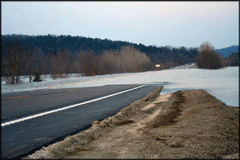
The Gasconade River pours over a highway near Mt. Sterling, Missouri in March. (Photo: Drew Backues)
GELLERMAN: From the Jennifer and Ted Stanley Studios in Somerville, Massachusetts - this is Living on Earth. I’m Bruce Gellerman, in for Steve Curwood.
The pictures from the Midwest are devastating and eerie. There haven’t been floods like this in the region in 500 years. So is this an extreme disaster of historic proportion or something worse: an ominous sign of what’s in store for us as climate change heats up the planet? One place to look for answers is the U.S Climate Extremes Index. It measures six indicators of extreme weather going back to 1910. The National Climate Data Center compiles the Extremes Index. Richard Heim is Acting Chief of the Climate Monitoring Branch, which is in charge of the Index. Mr. Heim, welcome to Living on Earth!
HEIM: Thank you Bruce, I’m glad to be here.
GELLERMAN: So you measure extreme conditions. What’s an extreme condition?
HEIM: The way we define extreme conditions for the Climate Extremes Index is the value has to be in what’s called the top ten percentile or the bottom ten percentile. The bottom ten percentile would be the hundred coldest or driest; the top ten percentile would be the hundred warmest or wettest. And you basically categorize each observation into its percentile based upon the historical record.
GELLERMAN: So are you seeing an increase or a decrease in the Climate Extremes Index?
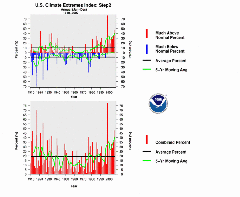
Extreme low temperatures (in blue) have disappeared while extreme high temperatures (red) are more frequent. (Courtesy of the U.S. Climate Extremes Index)
HEIM: We’re seeing an increase in the Climate Extremes Index in some of its components. The Climate Extremes Index itself, where all six are involved, shows a marked increase over the last couple decades if you look at the aggregate of all of the years combined together. But there are individual years earlier in the century that are just as extreme but they haven’t been as frequent as they are happening now in terms of the overall Index.
GELLERMAN: So which parts of the Index, which of these six indicators, are we finding more extreme now?
HEIM: There are three parts that are really more extreme in the last couple decades. They are the daily high temperatures, the daily low temperatures, and the extreme one-day precipitation events—the really heavy one-day rainfalls. The daily high temperatures have been happening more frequently in the high percentiles. In other words, we’ve been having really hot high temperatures more often in the last ten years and twenty years than we have earlier in the record. And the low temperatures have been on the warm side more often in the last twenty years than they have in the past. The number of really cold low temperatures and cold high temperatures has almost really disappeared in the last couple decades. And the number of extreme wet days, the extreme one-day precipitation events, has increased pretty strongly over the last couple decades. The last three or four years have seen spikes in that part of the index and also about three or four years in the 1990s—the 1993 floods for example show up in that particular component of the Index as well.

Flood water almost up to the roof line in Jefferson County, Missouri, in March. (Photo: Kristin Badolato)
GELLERMAN: Would we expect that if this was caused by global warming that that would cause more rain?
HEIM: Some of the global climate models that have been run for global warming simulations indicate that we should expect to see an increase in the frequency of really heavy rain events like these one-day extreme events and also the frequency of warm temperatures should be increasing and the frequency of cold temperatures should be decreasing. And these three components are reflecting that very, very well.
GELLERMAN: So the downpour in Iowa—can we attribute that to global warming?
HEIM: That’s a very good question and the answer is kind of, well…you can’t attribute any one event to global warming, like the downpours in a particular month or a particular year. Global warming will cause an increase in the frequency of these things. So when you look at the frequency over several years and you see it happening more and more often then you can have a greater confidence that that’s probably due to global warming.
GELLERMAN: Could there be other factors here, say La Niña or El Niño or you know, the weather just being…the weather?

The Gasconade River pours over a highway near Mt. Sterling, Missouri in March. (Photo: Drew Backues)
HEIM: Exactly. That’s what makes it so difficult to attribute any particular climate extreme or weather extreme to a particular cause because there are a variety of causes: the amount of energy coming from the sun, the circulation of the ocean currents, the circulation of the earth’s atmosphere—the jet stream and so forth. All of these things you have to kind of combine together and distill them down and determine which one is the dominant influence in a particular month. Right now, we’re at the waning end of a La Niña and we’re entering into what’s kind of called a “Neutral ENSO State” for the tropical Pacific so the other things that are influencing our weather are kind of rearing their heads now.
GELLERMAN: Can we use the Climate Extremes Index to predict conditions?
HEIM: No. The Climate Extremes Index is devised to put current anomalies into historical perspective—to show what’s happening now and what has happened in the past, to show us trends, how it compares historically. It is not a predictive tool.
GELLERMAN: So the trend is hotter and wetter and is that what we’re looking forward to in the future?
HEIM: According to the global climate models, that is what we can expect more of in the future, yes.
GELLERMAN: Well Mr. Heim, I want to thank you very much. I appreciate it.
HEIM: Thank you very much Bruce.
GELLERMAN: Richard Heim is the Acting Chief of the Climate Monitoring Branch of the National Oceanic and Atmospheric Administration.
Related link:
For more on the U.S. Climate Extremes Index, click here
[MUSIC: Radiohead “House Of Cards” from ‘In Rainbows’ (Xerbia_Xendless Limited—2007)]
Drilling for Votes
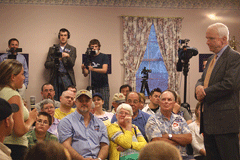
Seantor McCain fields a question about global warming while campaigning for the Republican primary in Merrimack, New Hampshire. (Photo: Marc Nozell)
GELLERMAN: The price of gas is soaring just as the race for the White House is heating up – putting oil front and center as a Presidential campaign issue. For 27 years the U.S. has banned drilling for oil and gas off the continental coast, and Republican Senator John McCain supported the moratorium, but now, he’s says he’s reconsidering his position. Living on Earth’s Jeff Young reports on petroleum politics and McCain’s electoral chances in November.
YOUNG: When Senator John McCain last ran for president in 2000 he opposed expanding offshore drilling—he called it a giveaway to special interests. The price of a gallon of gas during that campaign was about a dollar and a half. This is John McCain at four dollars a gallon.
MCCAIN: We have proven oil reserves of at least 21 billion barrels in the United States, but a broad federal moratorium stands in the way of energy exploration and production. And I believe it’s time for the federal government to lift these restrictions and put our own reserves to use.

Seantor McCain fields a question about global warming while campaigning for the Republican primary in Merrimack, New Hampshire. (Photo: Marc Nozell)
[CHEERS]
YOUNG: The oil-friendly crowd in Houston cheered. But McCain’s change of heart is a politically risky move that raises questions about his commitment to environmental protections in the face of economic pressure. McCain detailed his position at a press conference in his campaign’s headquarters in Virginia. There are two moratoria, one by the president, another from congress that cover most of the Atlantic and Pacific coasts. McCain wants to end them and give states control.
MCCAIN: I don’t want to dictate to the states what they should do, but I think that the states can be provided with additional incentives such as a greater share of revenues. So, I do believe that there are places in the world that we should not drill, but I certainly think there are areas off our coast that should be open to exploration and exploitation and I hope we can take the first step by lifting the moratoria in order to do so.
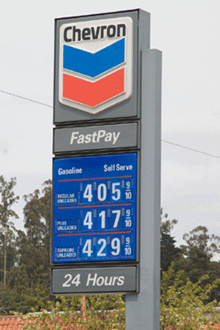
As gas prices continue to rise, political support for offshore drilling is growing. (Photo: Greg Woodhouse)
YOUNG: It’s not clear how many states might choose drilling. Virginia’s legislature and both the state’s U.S. senators support the idea. But most coastal states remain opposed. That makes it hard to guess how much oil or natural gas might be produced. Environmental groups say it also raises thorny questions about safety and who would suffer in an oil spill. Cathy Duvall is with the Sierra Club, which has endorsed McCain’s democratic opponent, Barack Obama.
DUVALL: The way that the tides and the currents work, if there were an accident off that shore it actually wouldn’t come onto shores of Virginia it would come on to New Jersey. So a state would be making a decision that involves some risks yet another state would bear the brunt if something were to happen.
YOUNG: Duvall says. And it’s unlikely that production from new leases would have any near term effect on gas prices. Oil industry experts agree it would take at least five to 10 years to produce new offshore oil. Still, the industry’s trade group, the American Petroleum Institute, welcomes McCain’s announcement. API’s senior economic advisor, Rayola Dougher, brushes aside any safety concerns.
DOUGHER: Because the technology is such that they have these safety valves in place if one pipe breaks the other one’s there to close it off. You do not have the spills that happened decades and decades ago—that is not possible with today’s technology. I think this would be a great move and it’s about time, it really is.

An oil rig aflame - environmentalists say accidents like this demonstrate that offshore drilling is damaging and dangerous. (Courtesy of the U.S. Department of the Interior)
YOUNG: It’s not necessarily that great for a candidate to be considered a friend of your industry these days, is it?
DOUGHER: Probably not. It takes a lot of guts! Ha ha.
YOUNG: McCain risks seeming too cozy with Big Oil and with President George Bush. The day after McCain’s energy speech the president echoed his call, challenging congress to drop the offshore drilling moratorium.
BUSH: Americans will rightly ask how high oil, how high gas prices have to rise before the democratic controlled congress will do something about it.
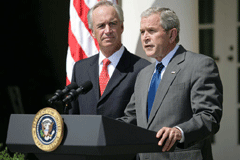
U.S. Interior Secretary Dirk Kempthorne (left) with President George W. Bush in the White House Rose Garden as he calls on Congress to expand domestic oil production. (Photo: Luke Sharrett, Courtesy of the White House)
YOUNG: McCain has hoped his early stand for action on global warming would set him apart from the unpopular president. This new campaign ad plays up McCain’s maverich status.
AD SOUND: John McCain stood up to the president and sounded the alarm on global warming five years ago. Today he has a realistic plan that will curb greenhouse gas emissions.
YOUNG: But the drilling issue could put McCain closer to his party’s pro-drilling wing, epitomized by New Mexico Senator Pete Domenici.
DOMENICI: It’s terrific. Offshore drilling is showing that he wants to produce some American energy. Because it’s ours. And we gotta be on oil and gas for a long time no matter what so why not use our own? He’s doing it the same way we recommended.
[NOISE OF CONGRESS HALLS]
YOUNG: McCain’s environmental supporters insist he’s still his own man on energy policy.
JENKINS: I think to suggest that his policies would be similar to the Bush administration or to some of the Republican leaders in Congress, is just silly.
YOUNG: That’s Dave Jenkins with the group Republicans for Environmental Protection, which endorsed McCain and now finds itself in a tichlish spot. Just a week before McCain’s drilling speech, the group argued that the oil industry has plenty of offshore leases it’s not using.
JENKINS: Our organization has not been big fans of offshore drilling. However it’s very clear that the public has an incredible concern about energy prices and everyone is struggling to find the right balance. What Senator McCain is doing is trying to find a good, balanced policy.
YOUNG: McCain’s also making some of his allies in important battleground states squirm a bit. Florida has long fought to protect its beaches and ocean views form oil spills and platforms. But Florida Republican Senator Mel Martinez says high-energy prices make McCain’s pro-drilling argument more attractive.
MARTINEZ: I’m kind of agreeing with him. So maybe things are changing in that regard. And, I think that four dollars a gallon has done that.
YOUNG: McCain hopes to tap into voter discontent on high gas prices. But it could come at the expense of his environmental appeal. For Living on Earth I’m Jeff Young in Washington.
Related links:
- Energy Information Agency analysis of offshore resources, showing limited impact on gas prices
- Sen. McCain’s speech in Houston June 17
- President Bush’s comments on offshore drilling June 18
- Mineral Management Services overview of offshore drilling safety and spills
[MUSIC: James Taylor Qt “Never In My Wildest Dreams” from ‘Live At The Jazz Café’ (Real Self Records—2008)]
GELLERMAN: Coming up: A warm river in a cold place is making salmon sich. That’s just ahead on Living on Earth.
[MUSIC: James Carter : “Dodo’s Bounce” from Present Tense (Emarcy Records 2008)]
Stripping Carbon

GELLERMAN: It’s Living on Earth, I’m Bruce Gellerman.
California is the first state in the nation with a law limiting carbon emissions. Now state officials, experts, industrial and environmental groups have to figure out how to put the law into practice. The California Air Resources Board will soon release its plan to make it work. But as Living on Earth’s Ingrid Lobet reports, that could be painful for just about everyone.
LOBET: To calculate how much California needed to reduce its emissions, the Air Resources Board first had to tally all the carbon emissions for 1990. That's because the state must return to that level of emissions in twelve years. The total equals 173 million tons of CO2 a year.
The largest piece of the emissions pie is movement - transport of people and goods. So California may be on the verge of telling cities and regions to track and reduce miles traveled within their borders. Dan Sperling heads the UC Davis Transportation Institute and is on the Air Resources Board. He says not all places will show net reductions if they're growing, since more people means more vehicle-miles.
SPERLING: You don't want to be anti-growth, so like, some region’s gonna grow, you don't want to punish them just because they’re growing, if they grow in a green sensible way, then that's good. So one way to handle this would be that per capita you must reduce your greenhouse gases by say, five percent, but per capita.
LOBET: Sperling says counties and cities could start tracking odometers. And at some point, he says the state could move toward individual mileage limits for people.
SPERLING: You know one day we might. Because the principal behind all of this is that we're not going really going to get major reduction in greenhouse gases until it enters the consciousness of everyone. And so, somehow, you know, you have to get everyone focused.
LOBET: Electricity also makes up a large share of the emissions pie. Here we're likely to see a trading system with a cap where some companies pollute less and others buy allowances to pollute more. So far California’s coal-heavy utilities have been pitted against those that use less coal, mirroring a national battle. Bob Sawyer is former chief of the California Air Resources Board. He says the challenge is to create a trading system that is cheat-proof.
SAWYER: There will be a real tendency to game the system. That is, the coal states, such as Montana, Wyoming, Arizona and New Mexico could sell their electric power to the Northwest. The Northwest could then sell their hydropower at a huge premium to California and it would make it appear that California's CO2 emissions from electricity consumption had gone down when actually absolutely nothing had happened.

The kiln of Hanson Permanente Cement produces more greenhouse gas than any other source in Santa Clara County – over a million tons a year. (Image Source: KQED QUEST - Some rights reserved)
LOBET: Sawyer and others say a power emissions trading system must include other western states and Canadian provinces, but it's unlikely this can be set up in time to meet California's tough timeline.
Oil and Gas is another industry with major emissions. The new plan will tighten regulations not only on its refineries, but on the recipes for its fuels. Governor Arnold Schwarzenegger took early action under the law and ordered refineries to reduce carbon in all fuels by 10 percent. Cathy Reheis Boyd of the Western States Petroleum Association says as corn ethanol faces increased scrutiny, that 10 percent has become more complicated.
REHEIS BOYD: And so all of a sudden we were left with what ARE we going to do to transform our fuels?
LOBET: Reheis Boyd says the energy executives she works with also hope the industry will be given credit for its practice of pumping CO2 underground into old oilfields.

California’s cities might have to track their residents’ odometers and then limit total miles traveled to meet the new law’s strict emission limits. (Photo: Sean Dreilinger/durak.org)
REHEIS BOYD: We actually have been using CO2 for decades in the oil and gas industry, and we have actually in the past - before climate change became an issue - purchased CO2 as a gas and pumped it underground to move oil. It is a wonderful mechanism to take difficult oil that is trapped underground and use the gas to pressure its release and allow it to flow easier to the surface.
LOBET: But the oil and gas industry comprises about nine percent of total emissions, so the plan will undoubtedly require changes in their business.
The cement industry may also have to change. Making the glue that holds concrete together is carbon intensive. It burns fuel - petroleum waste, coal, even old tires, in order to super-heat kilns where limestone - calcium carbonate - is roasted.
O'HARE: Taken together it is about one ton of CO2 per ton of cement produced.
LOBET: That's Andy O'Hare of the Portland Cement Association. There are eleven cement plants in California. Officials would like to keep them here, and they're mindful it's an industry that can relocate. Twenty-five percent of cement already comes from Asia. And O'Hare points out further regulation could lead to lawsuits.
O'HARE: For example if the state wanted to put up some type of energy efficiency requirement for imported cement from other countries as a means of leveling the playing field, it is uncertain how that could be done at this point without stepping over the boundaries of either the WTO rules or the interstate commerce clause. So it's an issue we are working closely with the state on. They are struggling right along with us.
LOBET: The industries mentioned here are only a few of those that will see powerful changes under the California carbon limit. And petroleum representative Cathy Reheis Boyd thinks residents are unaware of its reach.
REHEIS BOYD: I don’t think people have grasped what is being talked about here.
LOBET: But with residents paying $4.75 a gallon for gas, many are already beginning to recalculate life as we’ve known it, and adapt to a carbon-limited world. The California draft plan will be reviewed over the summer and adopted in November.
For Living on Earth, I'm Ingrid Lobet.
Related links:
- Keep track of California's progress
- California's greenhouse gas tailpipe law
- California's efforts on climate change
[MUSIC: Donald Fagan “Trans Island Skyway” from ‘Kamirakind’ (Warner Bros—2001)]
Sick Salmon

On the banks of the Yukon River, fisherman Pat Moore prepares king salmon to be hung in the smokehouse. It frustrates him when salmon show signs of “white spot disease," or Ich. “See, it’s all of the biggest, best-looking fish,” Moore says. “It breaks my heart.” (Photo: Rick Loomis/Los Angeles Times)
GELLERMAN: White Spot Disease is killing vast numbers of salmon along Alaska’s Yukon River. White Spot is caused by a parasite – appropriately named – “Ich”. Ich eats away at the internal organs and flesh of the fish. In some places along the Yukon River 30 percent of the salmon catch is infected with Ich. Kenneth Weiss—a Pulitzer Prize winning reporter for the Los Angeles Times—recently traveled to the area and he joins me from Los Angeles.
Ken – ich sounds really awful!
WEISS: It is awful, particularly to the fishermen who rely on the salmon that swim upstream in the Yukon. These are subsistence and traditional fishermen, Native Americans, who live along the river and have been fishing this way for decades. And they found that this fish that starts out with these little white pimples on the hearts of these salmon and then spreads to the flesh and makes them smell a bit like rotting fruit. And that’s become a real problem because they like to dry their fish in smokehouses and the whole batch can get tainted by this stuff. It really breaks the heart of these fishermen because it’s almost always the biggest and best looking fish, generally those large females that are carrying a lot of eggs needed to reproduce for successive generations. And they end up throwing away as much as 30 percent of their catch, feeding much of it to their dogs. Now these summer fishermen are also dog mushers in the winter so they have dozens and dozens of dogs but they end up throwing away so much fish it’s more than their dogs can eat.
GELLERMAN: So why are we seeing a problem now with Ich?

Ken Weiss covers the Pacific Coast and oceans for the Los Angeles Times. (Photo: Rick Loomis/Los Angeles Times)
WEISS: Well the fishermen first started noticing Ich in the late 1980’s and they didn’t know what was going on until they brought in an outside expert. There’s a fellow named Richard Kocan who’s a fish disease specialist at the University of Washington and he and his students started ruling out every possible reason that this disease was emerging and the only thing they found was it correlated with warmer water in the Yukon River. And the Yukon River’s water has been warming with an earlier break up of ice and particularly it’s been warming earlier in the season, in June. That’s when these Chinook salmon start their long migration to the headwaters about 2,000 miles away.
GELLERMAN: So the assumption is that global warming is heating the Yukon River and that’s causing this parasite to grow and thrive and that’s killing the salmon?
WEISS: That’s right. So the fish, unlike us warm blooded creatures, their body temperatures change with the ambient water, the water around them. So if they’re swimming in warmer water, it tends to accelerate the growth of this parasite as well as bacteria. It’s pretty much the same as when you take something out of your refrigerator and stich it on the counter too long and you find bacteria growing on it.
GELLERMAN: So are scientists expecting it to spread beyond the Yukon as things warm up?

On the banks of the Yukon River, fisherman Pat Moore prepares king salmon to be hung in the smokehouse. It frustrates him when salmon show signs of “white spot disease," or Ich. “See, it’s all of the biggest, best-looking fish,” Moore says. “It breaks my heart.” (Photo: Rick Loomis/Los Angeles Times)
WEISS: Yeah, since he’s been doing his work, it’s been found in salmon in rivers in British Columbia and in Kamchatka and elsewhere. It’s also showing up in some other types of fish such as the rockfish off of the Pacific Northwest, Oregon and Washington. Those are those bottom dwelling, great tasting fish that you see in the market often labeled incorrectly as red snapper or rock cod. And it showed up in other fish in the Puget Sound as well that we don’t eat. So one of the questions is: Is this a new arrival? Or are scientists simply finding it because they’re now looking for it? And there’s a debate about that. Ich, as it’s known, is what they call a cosmopolitan disease. It’s been around for a long time and it’s widespread but now it’s showing up in places that it’s never been found before and Doctor Kocan, at the University of Washington, he believes that salmon have been so closely monitored for so long that if it had been there, we would have seen it before.
GELLERMAN: Would we expect to see something like this, say, in the southern hemisphere, say South Africa or Chile?
WEISS: I think one of the things that these disease experts are seeing is that the whole geographical spread of disease is on the move with climate change. All sorts of different bugs, whether they’re bacteria or protozoa parasites or whatever can be limited by temperature. And when those temperature barriers fall, those bugs are quich to move into new ground. At the same time, I think there may be some places in the tropics where these bugs no longer persist—they just don’t thrive because it gets too hot. But I think we’re less likely to hear about those diseases that disappear as opposed to ones that emerge in new areas.
GELLERMAN: What, if anything, can be done to help these fish?
WEISS: Well, it’s difficult to know what to do. One thing that is an obvious implication for this research is to cut back on how many fish are taken through the commercial fishery. The commercial fisheries where we get our prized Alaskan salmon are usually down at the mouths of these rivers, it’s when the fish just start to swim upstream. Now those fish are, in the Yukon for instance, are infected with this parasite but the disease has not progressed. As the fish swim up the river, in warmer water, the disease progresses, and the idea is, if Doctor Kocan is right, that some of these fish are dying on the way up to their spawning grounds, that you need to cut back on the catch to compensate for that.
GELLERMAN: Ken Weiss is a Pulitzer Prize winning reporter for the LA Times. Ken, thanks a lot.
WEISS: Thank you.
Related link:
Check out the L.A. Times' multimedia coverage of sick salmon
Big Ocean, Big Picture

Behind the traditional sea-front houses, there’s heavy industrial and commercial development in South Boston coastline. (courtesy: Massachusetts Ocean Partnership)
GELLERMAN: Massachusetts Governor Deval Patrich recently signed landmark legislation into law. It’s a brand new approach to using the ocean’s resources.
PATRICH: The Oceans Act of 2008 will make Massachusetts the first state in the nation to require a comprehensive science-based plan for the management of our ocean waters.
[HARBOR NOISES]
GELLERMAN: Here in Boston Harbor, once the place of a Revolutionary tea party, is where the revolutionary plan to manage the state’s coastline is taking shape.
MOURA: If you look around here you could swivel your head 180 degrees and see so many of the uses we’re talking about that are competing for ocean space.

Stephanie Moura, Executive Director of the Massachusetts Ocean Partnership, stands on the shores of Boston Harbor. (courtesy: Massachusetts Ocean Partnership)
MOURA: You’ve got a power plant across the way. You’ve got Mass Port’s Connelly Terminal right there, that’s the Port of Boston Harbor. You’ve got swimming beaches right over there in South Boston, urban swimming beaches. You’ve got the Deer Island Sewage Treatment Plant. You’ve got the Boston Harbor Islands, which is a major recreational destination now.

A power plant situated on Boston’s shores.
(courtesy: Massachusetts Ocean partnership)
GELLERMAN: You’ve got Boston, Logan Airport is over there and then you’ve got those LNG tanks over there.
MOURA: Yup, yup. There’s offshore LNG terminals here. If you could swivel your head that way just a bit you would see wind turbines off Hull. Now the current one there is land based but as you know there’s a lot of proposals and interest for various offshore renewable energy proposals in the water. So energy, fishing, shipping, power—you’ve got everything right here and this is only maybe two miles we’re looking at. We’ve got almost 1,900 miles of coastline to manage.
GELLERMAN: This is really an extraordinary view, this is an extraordinary historically, commercial, it’s fantastic.
MOURA: It’s fantastic, it really is.
GELLERMAN: So as I understand it, you take the stakeholders, the people who are involved directly making their earning, their living, using the ocean and the regulators, you throw in scientists, look at the ocean as a whole, and voila!

Behind the traditional sea-front houses, there’s heavy industrial and commercial development in South Boston coastline. (courtesy: Massachusetts Ocean partnership)
MOURA: And voila. You theoretically then have a better way to manage the ocean resources than what we have right now which is permit by permit. You know somebody says, “I’d like to put this wind farm there or that LNG terminal there,” and there’s no big picture, there’s nobody looking at the big picture to say, “Does this make sense here over time? What, who’s going to benefit and who’s going to lose?”
GELLERMAN: What took you soon long?
[MOURA LAUGHS]
MOURA: In some ways, I think the status quo is just very compelling. This is the way we’re used to doing things, so if it’s not that broken, why change it. But I think what’s happening here in Massachusetts and similar pressures elsewhere is that you see first of all more and more evidence that the ocean ecosystems are in jeopardy—you know, ecologically in tough shape. And one of the impetuses for trying to do things differently is that we’re trying to make sure that the ecosystems remain resilient so that they can continue to generate all these goods and services that we rely on.
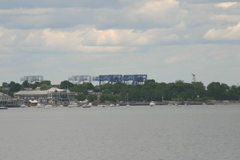
Boston’s shipping port.(courtesy: Massachusetts Ocean partnership)
However in the face of that we’ve got this massive, increasing interest or intensifying demands. There’s proposals right and left for energy development, coastal development, various desalination plants, whatever it happens to be. So you’ve got trouble brewing, plus increasing demand that means “Uh oh, we better find a way to manage these things that’s more sustainable.”
GELLERMAN: And how will you know if this is successful or not?
MOURA: I really think that the proof will be in the pudding if the user groups and the interest groups can say, “You know what? I participated in this, it isn’t perfect, but I can live with it and I think it’s a lot better than where we were eighteen months ago.”
GELLERMAN: And will the society, the people who live in Massachusetts, will they ultimately, do you think, really think, that this will help protect what they’ve got, preserve it for the future, and allow them to use it?

The Deer Island sewage treatment plant was an integral part in cleaning up Boston coastal waters. (courtesy: Massachusetts Ocean partnership)
GELLERMAN: When you think about this, it’s so ambitious, does it give you the willies? I mean, you gotta really make this thing work.
MOURA: Yes. I get up every morning and think, “Do I love this job or hate this job?” and mostly I come down on that I love it. It is, it’s a fantastic challenge. Fantastic because there’s all the politics involved and that is a messy but wonderful puzzle. There’s a shortage of resources—and when I say resources here I’m talking funding—and so the fact that the partnership has been able to amass this private funding to help interject in the process is going to be a tremendous help, I think, to move things forward. But it is gonna be, especially in an eighteen month timeframe, it is going to be heavy lifting every day and it’s going to take a lot of cooperation. We’re going to have to build new levels of cooperation and that is, that’s exciting.
GELLERMAN: Well Stephanie good luck. I think you’re gonna need it.
MOURA: Thank you Bruce. I can guarantee you we’re going to need and I appreciate your time.
GELLERMAN: Stephanie Moura is the Executive Director of the Massachusetts Ocean Partnership.
Related links:
- The Massachusetts Oceans Act of 2008
- The Massachusetts Ocean Partnership
[MUSIC: Robbie Robertson With Galactic “Going To The River” from ‘Goin Home: A Tribute To fats Domino’ (Vanguard Records—2008)]
GELLERMAN: Coming up: How many Congressmen does it take to screw in a compact fluorescent light bulb? Stay tuned to Living on Earth!
[MUSIC: Sly & Robbie: “Village Caller” from Mambo Taxi (Island Jamaica Records 1997)]
Plug-in Cars

GELLERMAN: It’s Living on Earth. I’m Bruce Gellerman.
Pacific Gas and Electric serves five point one million customers and it’s fair to say very few, if any, use their electricity to power a car. Well, soon that’s going to change. Several auto manufacturers are promising plug-in electric vehicles will be available by 2010 and PG&E wants to be ready with the energy infrastructure when the cars hit the road. The West Coast utility has announced it’s investing billions of dollars to build what it calls the smart grid. Jill Egbert is manager of Pacific Gas and Electric’s clean air transportation program, and she joins us from the studios of KQED in San Francisco. Welcome Jill!
EGBERT: Thank you Bruce.
GELLERMAN: So the idea as I understand it is that instead of stopping by a gas station on the way home, I just pull into my garage and plug in.
EGBERT: That’s the future vision that we see. And we’re working very hard on the infrastructure, the communications, and the control technologies to make that a reality for our customers. The near term application would be what’s termed “smart charging” where you would come home, plug your vehicle in, and then a smart meter would actually start charging your vehicle in off-peak hours so you’re charged the least amount of money. We hope to have all those smart meters in place by 2012 and this technology could become a reality.

(George W. Hatcher)
GELLERMAN: And off-peak hours are traditionally late at night.
EGBERT: Correct. That’s between midnight and six in the morning.
GELLERMAN: These vehicles will have a limited mileage they can go and how can you be so sure that people are going to plug them to charge in off-peak hours? What happens if everyone starts plugging them in right in the middle of the day when you need the electricity the most?
EGBERT: We want to work closely with our customers to educate them because if they do plug in during peak hours it’s gonna cost them a lot more money to fuel that vehicle.
GELLERMAN: Is it going to be that significant where I just say it’s “Ah, you know, it’s a couple of pennies and so what?”
EGBERT: I think it’s five cents off-peak and probably closer to 25 or 30 cents on peak.
GELLERMAN: Boy, I imagine if people could do that with gasoline right now we’d have a whole different reality.
[EGBERT LAUGHS]
GELLERMAN: If I have a fully charged electric car sitting outside my house, storing energy in my batteries, could I not then send it back to you and sell it to you?
EGBERT: We see that as a very, very long-term vision, maybe 15 to 20 years out. Probably the first thing that you would, we would be seeing is that if you had that battery full and say your power went out in your neighborhood you could actually use the energy in the battery to power up a few essentials in your home while the utility actually came to turn your power back on. There would be enough power in the battery to keep your T.V. on, your refrigerator on, and maybe a couple of lights.
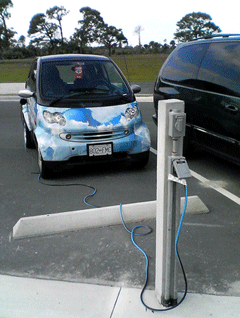
(Courtesy of Pacific Gas and Electric)
GELLERMAN: So it would turn electricity into a two-way street.
EGBERT: Yes, what you’re talking about is what’s termed vehicle-to-grid technology where you would use the energy in your battery to sell it back to the utility during critical peak times and that’s gonna take a lot of technology, two-way communications to make that a reality but maybe, you know, 15 to 20 years out.
GELLERMAN: Well, today, what can your grid handle in terms of electric cars?
EGBERT: In California, the grid can handle 3.9 million plug-in hybrid vehicles today. And PG&E’s about 40 percent of that so we’re looking at close to two million vehicles that our grid could handle today.
GELLERMAN: Where would all of this electricity come from? I mean in the United States about, what, 50 percent of our energy comes from coal. So if I’m powering my car with that type of electricity I’m, you know, I’m not doing much good for the environment, am I?
EGBERT: I agree, I agree. PG&E’s energy portfolio is among the cleanest in the industry—over 50 percent of our energy portfolio is CO2-free. We have a large portion of hydro, nuclear, natural gas. We only have one percent coal.
GELLERMAN: Now PG&E is in the business of making not just electricity but money, right?
EGBERT: Well, actually we are de-coupled in California and we do not make money on additional sales of electricity.
GELLERMAN: So how are you going to make money out of this venture? It’s going to cost you billions of dollars.
EGBERT: We see the opportunity to better utilize our assets and hopefully be able to lower rates for all of our customers in the long run.
GELLERMAN: So it’s a matter of efficiency. If people plug in their cars overnight, it makes your grid more efficient because PG&E has to be generating that electricity overnight anyhow so you may as well put it to good use, and I get to put it in my car, and we’ll all come out ahead.
EGBERT: That’s exactly right. We are generating that electricity to serve our customers. We want to utilize our assets to their most potential.
GELLERMAN: Chevy has a new car coming out in 2010 called the Volt. And Prius, Toyota’s Prius, is going to be coming out with a competing car, a plug-in hybrid, in about the same time frame now they’ve announced. So I guess the idea for PG&E is that you’ll build it, and they will come.
EGBERT: We’re working very closely with the auto manufacturers to make sure that we are all in alignment and it’s a seamless transition for the customers. We want to make sure our customers are educated to plug those vehicles in off-peak so that we don’t have to build additional infrastructure to support these vehicles.
GELLERMAN: Well Jill thank you very much, I appreciate your time.
EGBERT: Thank you so much, Bruce, for having me.
GELLERMAN: Jill Egbert is manager of Pacific Gas and Electric’s “Clean Air” transportation program.
Related links:
- Pacific Gas and Electric website
- Previous LOE coverage on electric cars
[MUSIC: Radiohead “All I Need” from ‘In Rainbows’ (Xerbia_Xendless Limited—2007)]
Green Living by the Book
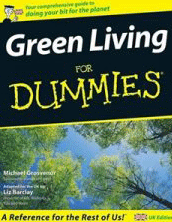
(Green Living For Dummies)
GELLERMAN: Americans love self-help books. They help us win friends and influence people and make lots of money for publishing companies. Now a new crop of these books promises to help us green up our lives. Bruce Barcott has the dirt on the growing field of green guidebooks.

("Green Living for Dummies")
What we’ve got here is a 350-page book packed with ways to green up your life: Composting, community gardens, wind power, car sharing. There are even some tips on patching carpets and fixing vinyl flooring. The problem isn’t the content. It’s the form. “Green Living for Dummies” may be one of the ugliest books I’ve ever read—or rather, tried to read. The illustrations are crude, the writing is bland, the typeface actively repels the eye! The underlying message is clear: Living green will be a bore and a chore. Eat your spinach.
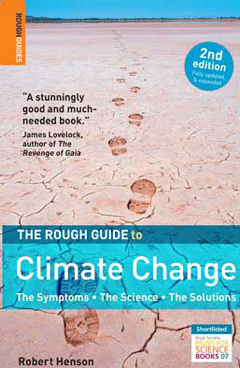
"The Rough Guide to Climate Change"
That’s a shame. The whole point of green living today is that it’s not a drab, wheat-germy lifestyle. Today’s most beautiful buildings and hippest products are the result of green architecture and cradle-to-cradle innovations.
Fortunately, other guidebooks are aware of the new paradigm. The Rough Guide travel series recently expanded into reference guides, and “The Rough Guide to Climate Change” is a small masterpiece of smart design and clear, compelling information. Author Robert Henson works with climate scientists at the National Center for Atmospheric Research, but he doesn’t drown his readers in data. He asks big questions like, ‘Where did all this CO2 come from?” and answers them with shocking photos, eye-catching charts, and sparkling prose. “The Rough Guide” just might be the world’s first climate change bathroom book.

"Go Green, Live Rich"
David Bach takes a different tack altogether. Bach is the author of bestselling personal finance books like “The Automatic Millionaire” and “Start Late, Finish Rich.” Now he’s expanding into greener living pastures with a new book called “Go Green, Live Rich.” This is a beautiful little book with a simple message: You can save the earth and get rich trying. Bach even does the math for you. Improve your car’s gas mileage and save 884 dollars a year. Turn your thermostat down: 85 dollars. Bring your lunch to work: 15 hundred dollars. Invest that money and watch it grow. “With just four of the tips in this book,” Bach writes, “you could earn nearly $700,000 for your future.”

("The Last Flight of the Scarlet Macaw")
Bach doesn’t just harness greed in the cause of good, though. Along with co-author Hilary Rosner, he’s put together a guidebook that contains the one secret ingredient guaranteed to transform a good idea into a finished product. You know what it is? He’s got 50 tips, and they all look like fun. That’s something even a dummy like me can understand.
GELLERMAN: Bruce Barcott is the author of “The Last Flight of the Scarlet Macaw: One woman’s fight to save the world’s most beautiful bird,” recently published by Random House.
Related links:
- "Green Living for Dummies"
- "The Rough Guide to Climate Change"
- "Go Green, Live Rich"
- Bruce Barcott's latest book "The Last Flight of the Scarlet Macaw"
Greening the Capitol

The US House of Representatives and the Senate are located in the US Capitol Building in Washington, DC. (Courtesy of Architect of the Capitol)
GELLERMAN: So, how many Congressmen does it take to screw in an energy efficient light bulb? Well, last year House majority leader Nancy Pelosi set a goal for the House of Representatives to be carbon neutral by the end of the 110th Congress, just 6 months away. So how are lawmakers doing? Dan Beard is the House Chief Administrative Officer and he’s in charge of greening the Capitol. He joins me from our studio on the hill.
Mr. Beard, welcome to Living on Earth.
BEARD: Thank you very much. It’s wonderful to be with you.
GELLERMAN: So how’s the greening going?
BEARD: It’s going very well. As you said in your introduction, we set a goal of being carbon neutral in our operations by December of this year and we will make it, I think we will make it several months in advance of that. And the second goal we set was to reduce our energy consumption by 50 percent over the next ten years, five percent a year for ten years. And the first year we reduced our energy consumption by six percent so we feel pretty good about the progress we’re making.
GELLERMAN: Well, it was George Washington who laid the cornerstone for the Capitol Building way back in 1793 and I know it’s gone through many changes since then, it’s been burned down, it’s been expanded, but it’s still an old, drafty building as I recall—I used to work there.
BEARD: Yes, it’s very old and very drafty. The House of Representatives has six million square feet of office space. Our half of the Capitol is the oldest building, 1793, and it gives you an idea of the kind of antiquated infrastructure we have to work with but you can do it if you have a commitment to it.
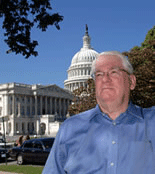
Dan Beard is the Chief Administrative Officer for the US House of Representatives. Part of his job is to make the House of Representatives be carbon neutral by the end of this year. (Courtesy of the US House of Representatives)
GELLERMAN: So how do you do it? I mean you’ve got this old power plant that’s dedicated to powering the Capitol Building and historically almost half the power comes from that facility and it comes from burning coal.
BEARD: We quichly developed a plan. We assessed and calculated our carbon footprint. And the first thing we did was to decide to purchase electric power only from renewable sources. The second thing we did was direct the architect of the Capitol who runs the Capitol power plant to burn only natural gas to meet our needs. And then the last thing we did for this year anyway is we bought some carbon-offset credits and retired them. And all three of those together will make us together will make us carbon neutral well before our deadline of December.
GELLERMAN: So, solar panels on the top of the Capitol Dome?
BEARD: Uh, not quite. But we are working to light the Capitol Dome with energy efficient lighting, LED lights. The Capitol is a symbol of democracy, it’s one of the most recognized buildings in the world, and there’s something very satisfying to think that it’s, it’ll be lit with energy efficient lights and our operating costs, yearly operating costs for lighting the Dome, will decrease by 50 percent as a result of installing those lights. Everything that we’re doing saves money. It ultimately results in savings to the taxpayer and I think that that’s the right thing to do. I think it’s irresponsible not to do it. For example, compact fluorescent light bulbs, you know, we directed our facilities manager to replace 30,000 light bulbs in the House of Representatives. We will save 120,000 dollars a year on our lighting bill as a result of installing those compact fluorescent light bulbs—Over a ten year period, over 1.2 million dollars.

The US House of Representatives and the Senate are located in the US Capitol Building in Washington, DC.(Courtesy of Architect of the Capitol)
The savings are real and they’re very significant. And it takes place very quichly: in the case of compact fluorescent light bulbs, it takes four months for them to repay the cost in terms of energy savings and on the fifth month you’re making money. There are lots of other things that you can do, such as, we have reduced our run time on our air conditioning system. Our buildings are open 24/7 but we have turned up the air conditioning—I think that’s the right phrase, or turned it down—we’ve made it warmer in the middle of the night and we just changed our run times and we got a 15 percent savings in our electric bills. We’ve got a lot of things to do in front of us, there’s a lot of things we could be doing, but we’re very excited about it.
GELLERMAN: Well, lawmakers are a lot like an army, they operate on their stomach. You serve a lot of food there. What, if anything, are you doing to green your cafeterias?
BEARD: We serve 230,000 meals a month. All of those food service facilities are now green. We have banned Styrofoam and plastic and all of the utensils you use—the plates, the cups, all the flatware, everything—is compostible. And the result is that we have reduced our contributions to landfills by 50 percent. Also, our food service operation is emphasizing locally grown products within a 150 mile radius of the capital, so that saves on transportation costs for food items and the food is fresher.
GELLERMAN: But it seems it takes more than physical changes. You’ve got a lot of people working there, you gotta change behaviors.
BEARD: I think that’s probably our biggest challenge. We’ve switched now to only using 100 percent post-consumer recycled paper. We did a contract with Zipcars and we now have Zipcars located in our garages and those are available to our staff. But their daily lives are changing too. I mean we are trying to move computer servers out of individual offices because what we found is by having servers in offices they tend to heat up the offices so much then you have to turn up the air-conditioning to cool it and you know you’ve just created a larger problem.
GELLERMAN: Well Mr. Beard, thank you so very much. I appreciate it.
BEARD: I appreciate it and anytime.
GELLERMAN: Dan Beard is Chief Administrative Officer of the US House of Representatives.
Though the Capitol building may be growing ever more green – just down the street at the White House there’s a different perspective. The President says we’re addicted to oil and should drill off our coast to get it. So we leave you this week with a song from the Capitol Steps.
Related link:
Green the Capitol Building Website
[MUSIC: Capitol Steps “Addicted To Oil” from their Website http://www.capsteps.com/)]
GELLERMAN: On the next Living on Earth: A new book says you should protect biodiversity as if your life’s at stake because it is…
VOICE: It's imperative that people understand the biodiversity - the variety of life out there-- is connected to their own health so that they think about it in terms of how it may affect the species that their health depends on.
GELLERMAN: Biodiversity – what’s in it for you – next time on Living on Earth.
We leave you this week, in the midst of desert winds…
[Earth Ear: Ruth Happel “Desert Serenade” from ‘Desert Solitudes’ (Wild Sanctuary Records—2002)]
GELLERMAN: At Grey Ranch, a 500 square-mile nature conservancy, eased in the panhandle of New Mexico, ravens, western meadowlarks, and mockingbirds, greet the dawn. Ruth Happel recorded this serenade, which appears on the Wild Sanctuary dot com c.d., Desert Solitudes.
GELLERMAN: Living on Earth is produced by the World Media Foundation. Our crew includes Ashley Ahearn, Bobby Bascomb, Eileen Bolinsky, Ingrid Lobet, Helen Palmer, Mitra Taj and Jeff Young, with help from Jennifer Baessler and Sarah Calkins.
Our interns are Kim Gittleson and Jessica Ilyse Smith. Jeff Turton is our technical director. Alison Lirish Dean composed our themes. You can find us at LOE dot org. Steve Curwood is our executive producer. I’m Bruce Gellerman. Thanks for listening.
ANNOUNCER: Funding for Living on Earth comes from the National Science Foundation, supporting coverage of emerging science, and Stonyfield Farm: organic yogurt and smoothies. Stonyfield pays its farmers not to use artificial growth hormones on their cows. Details at Stonyfield dot com. Support also comes from you our listeners, the Ford Foundation, the Town Creek Foundation, and the Oak Foundation, supporting coverage of climate change and marine issues. The Rockefeller Foundation and its campaign for American Workers, more at rockfound dot org and Pax World Mutual Funds: socially and environmentally sustainable investing. Pax World: for tomorrow. On the web at paxworld dot com.
ANNOUNCER 2: PRI: Public Radio International.
Living on Earth wants to hear from you!
Living on Earth
62 Calef Highway, Suite 212
Lee, NH 03861
Telephone: 617-287-4121
E-mail: comments@loe.org
Newsletter [Click here]
Donate to Living on Earth!
Living on Earth is an independent media program and relies entirely on contributions from listeners and institutions supporting public service. Please donate now to preserve an independent environmental voice.
NewsletterLiving on Earth offers a weekly delivery of the show's rundown to your mailbox. Sign up for our newsletter today!
 Sailors For The Sea: Be the change you want to sea.
Sailors For The Sea: Be the change you want to sea.
 The Grantham Foundation for the Protection of the Environment: Committed to protecting and improving the health of the global environment.
The Grantham Foundation for the Protection of the Environment: Committed to protecting and improving the health of the global environment.
 Contribute to Living on Earth and receive, as our gift to you, an archival print of one of Mark Seth Lender's extraordinary wildlife photographs. Follow the link to see Mark's current collection of photographs.
Contribute to Living on Earth and receive, as our gift to you, an archival print of one of Mark Seth Lender's extraordinary wildlife photographs. Follow the link to see Mark's current collection of photographs.
 Buy a signed copy of Mark Seth Lender's book Smeagull the Seagull & support Living on Earth
Buy a signed copy of Mark Seth Lender's book Smeagull the Seagull & support Living on Earth

